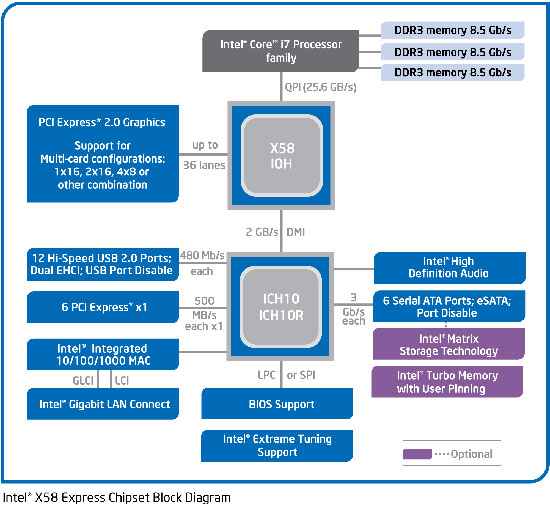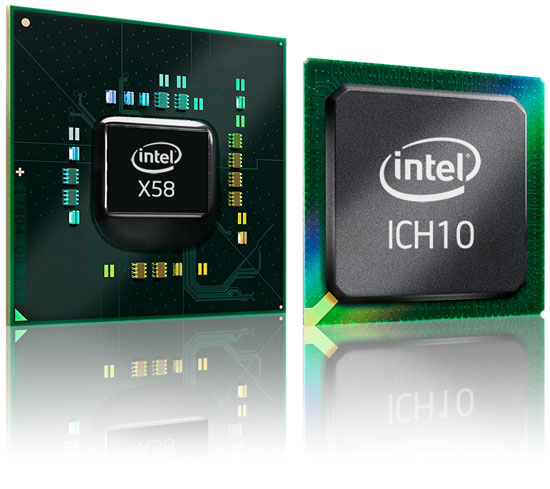The Dark Knight: Intel's Core i7
by Anand Lal Shimpi & Gary Key on November 3, 2008 12:00 AM EST- Posted in
- CPUs
The Chipset - Meet Intel's X58
Nehalem moves the North Bridge and memory controller on-die, but just like in the AMD world there's still a need for an off-die chipset, in this case it's Intel's brand new X58.
The Intel X58 chipset is a two chip solution although later next year Intel will introduce a single chip solution alongside the mainstream version of Nehalem (which will use a different socket). Traditionally Intel referred to its North Bridge as the MCH, shorthand for Memory Controller Hub; that definition no longer applies to Nehalem so X58 is called an I/O Hub (IOH).

The X58 IOH attaches to the same ICH10 (I/O Controller Hub) that is used in Intel's 4-series chipsets.

The biggest feature of X58 is that with proper "certification" by NVIDIA, motherboard makers can include support for the right BIOS flags to allow NVIDIA's drivers to enable SLI on the platform. Meaning the X58 will be the first Intel chipset to support both CrossFire and SLI multi-GPU solutions without the use of any NVIDIA silicon. There's a per-motherboard fee from NVIDIA for each certified X58 board sold and thus not all boards will be certified, the most prominent of which is Intel's own X58 board. Luckily we also had access to ASUS' P6T Deluxe which is certified, giving us the ability to look at CrossFire and SLI scaling on X58 vs. other platforms.










73 Comments
View All Comments
Jingato - Monday, November 3, 2008 - link
If the 920 can easily be overclocked to 3.8Ghz on air, what intensive is there to purchase the 965 for more that triple the price?TantrumusMaximus - Monday, November 3, 2008 - link
I don't understand why the tests were on such low resolutions... most gamers are running higher res than 1280x1024 etc etc....What gives?
daniyarm - Monday, November 3, 2008 - link
Because if they ran gaming benchmarks at higher res, the difference in FPS would be hardly visible and you wouldn't go out and buy a new CPU.If they are going to show differences between Intel and AMD CPUs, show Nehalem at 3.2 GHz vs 9950 OC to 3.2 GHz so we can see clock for clock differences in performance and power.
npp - Monday, November 3, 2008 - link
9950 consumes about 30W more at idle than the 965XE, and 30W less under load. I guess that OC'ing it to 3,2Ghz will need more than 30W... Given that the 965 can process 4 more threads, I think the result should be more or less clear.tim851 - Monday, November 3, 2008 - link
Higher resolutions stress the GPU more and it will become a bottleneck. Since the article was focussing on CPU power and not GPU power they were lowering the resolution enough to effectively take the GPU out of the picture.Caveman - Monday, November 3, 2008 - link
It would be nice to see these CPU reviews use relevant "gaming" benchmarks. It would be good to see the results with something like MS flight simulator FSX or DCS Black Shark, etc... The flight simulators these days are BOTH graphically and calculation intensive, but really stress the CPU.AssBall - Monday, November 3, 2008 - link
No, they don't, actually.philosofool - Monday, November 3, 2008 - link
It would have been nice to see a proper comparison of power consumption. Given all of Intel's boast about being able to shut off cores to save power, I'd like to see some figures about exact savings.nowayout99 - Monday, November 3, 2008 - link
Ditto, I was wondering about power too.Anand Lal Shimpi - Monday, November 3, 2008 - link
Soon, soon my friend :)-A